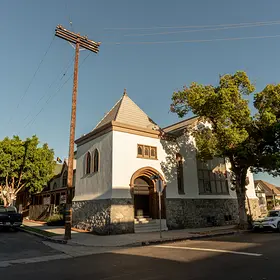
A Preservation-Minded Priest on an L.A. Church's Legacy and Restoration
For Chicano Movement activists in the 1960s and ’70s, the Church of the Epiphany in Los Angeles’ Lincoln Heights neighborhood served as an important base. Planning meetings for rallies and protests took place in the basement, the movement newspaper La Raza operated there for a time, and Cesar Chavez regularly spoke at the Episcopal church. Over the decades, many Central American worshipers joined the longtime Mexican American members, and today the congregation’s leaders still advocate for social justice. The Rev. Tom Carey, a diocesan priest who has led the church for the past 12 years, stepped down in June; we spoke with him shortly beforehand.
The church was listed on the National Register in 2020. What led to that designation?
It’s a very pretty building, a beautiful building, which alone is reason enough. But the real reason is that the landmarks we have tell us who we are and what we value. This is an American story of a group, a minority group, demanding their rights, and of the sometimes-active oppression of the larger society. The American story is that story. The [listing] reminds us of that. This is what we need in order to fully see ourselves.
When you started at Church of the Epiphany, what was the condition of the buildings?
There was one acute thing in the Arthur Benton–designed part [the church building, which dates to 1913]: All four stained-glass windows on the south side were in danger of falling out. And on the north wall of the parish hall, which is from [around] 1887 and was designed by Ernest Coxhead, the base of the building had eroded so the wall itself was in danger of collapse. You could see daylight coming through. A month after I started in 2010, I met the architects I ended up working with, Frank Escher and Ravi GuneWardena. They came to the church and agreed to work with us as a pro bono project.
Over the next few years, a lot of work took place, including fixing the stained-glass windows and wall. What inspired you to apply for a National Fund for Sacred Places grant?
Linda Dishman of the L.A. Conservancy made us aware of the grant opportunity from the National Fund for Sacred Places. We embarked on the idea of renovating the basement, so you could have more than one event there at the same time. This way we can actually have three meetings at once. The grant also allowed us to repair the main roofs on both buildings. We completed that work in 2021.
What groups are currently using the church and parish hall as meeting space?
We have a summer mentoring program from Lincoln High School that started in 2021 and will take place again this summer. It’s a group of local teenagers doing community service in partnership with the church. Narcotics Anonymous and a local renters group fighting gentrification both use the space. And we have a twice-a-month food bank.
What are some of the other preservation needs?
The shingled [upper] facade of the parish hall is in bad need of restoration. Also, the interior lighting needs to be upgraded. It’s terrible. There are issues with the back stairs. In the church’s narthex, the ceiling is in danger of collapse. The wood is rotten and could go at any time.
Sacred Places: The National Fund for Sacred Places

Church of the Epiphany received a $250,000 grant in 2017 from the National Fund for Sacred Places, a cooperative program of the National Trust and Partners for Sacred Places.
In addition to its history, why is the church so important?
It’s always been a place to meet, whether for religious reasons or activist reasons. Our society still needs that. All the things that happen in person—the intimate conversations, the side conversations, the things before and after—you can’t have that online. The transmission of that invisible thing, the enthusiasm of being together; it’s not impossible to do online, but it’s very difficult.



